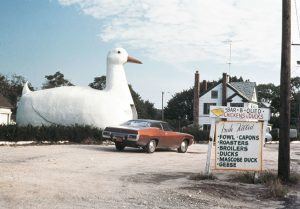Fredric Jameson at Artforum:
 So it is that underneath Venturi and Brown’s extraordinary analysis of the decorated shed, Rome slowly appears in all its glory and monumentality. The facades of the great cathedrals move out to the street and become signs and ads of varying proportions (depending on the speed of the drivers); St. Peter’s vast square becomes a parking lot, the basilica a casino, and the side chapels so many dimly lit gambling salons under low ceilings. This is truly another form of historicism, the one we deserve; and it accommodates the theory. For the concept of the decorated shed explicitly tells us to do what we like with the space of the shed, to pray, sleep, give speeches, store our boxes, repair our cars: It is a form and not a content. Is it a structure, like Adam’s house in paradise? Perhaps, but then in that case, unlike the duck (where the ad or sign has been amalgamated with the monument itself), the structure is a tripartite one: the sign or facade, the parking lot, and then the basilica itself, the showcase or display space versus the back room (as Erving Goffman might have put it), where its unconscious, perhaps, or its hidden meanings (Freudian or ideological), its secret intentions or “programs,” live.
So it is that underneath Venturi and Brown’s extraordinary analysis of the decorated shed, Rome slowly appears in all its glory and monumentality. The facades of the great cathedrals move out to the street and become signs and ads of varying proportions (depending on the speed of the drivers); St. Peter’s vast square becomes a parking lot, the basilica a casino, and the side chapels so many dimly lit gambling salons under low ceilings. This is truly another form of historicism, the one we deserve; and it accommodates the theory. For the concept of the decorated shed explicitly tells us to do what we like with the space of the shed, to pray, sleep, give speeches, store our boxes, repair our cars: It is a form and not a content. Is it a structure, like Adam’s house in paradise? Perhaps, but then in that case, unlike the duck (where the ad or sign has been amalgamated with the monument itself), the structure is a tripartite one: the sign or facade, the parking lot, and then the basilica itself, the showcase or display space versus the back room (as Erving Goffman might have put it), where its unconscious, perhaps, or its hidden meanings (Freudian or ideological), its secret intentions or “programs,” live.
more here.
